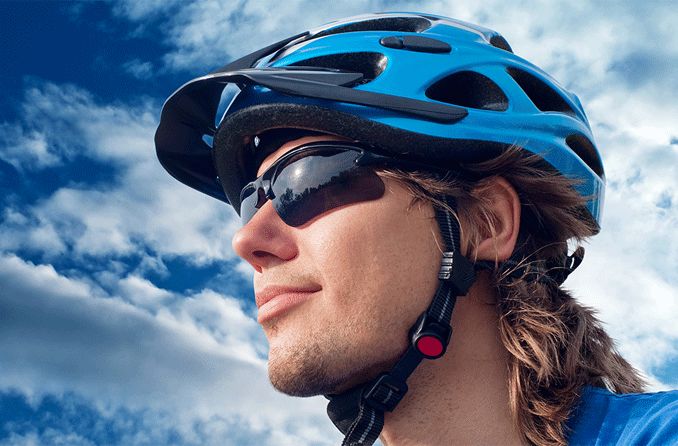Sports and performance eye-wear, glasses and sunglasses

Sports glasses are spectacles and sunglasses specially designed to:
Fit securely and comfortably during physical activity
Keep your eyes safe
Enhance your vision to give you a performance "edge" in the sports you love
In most sports, vision drives performance. So to excel during competition, you should make sure your eyesight is in top shape. Even if you have 20/20 vision (referred to as 6/6 here and in New Zealand), the right sports eye-wear can reduce glare and enhance contrast to help you see even better and react faster.
Sports glasses boost performance
Sports vision specialists agree that sports eye-wear can have a profound effect on athletic performance, and coaches agree. For this reason, many professional sports team have a dedicated optometrist who is a sports vision specialist.
Sports glasses, goggles and eye protection
Experts agree that most sports-related eye injuries can be prevented if athletes wear protective eye-wear, such as safety goggles with polycarbonate lenses.
Ski goggles are considered a must on the slopes to reduce glare and protect your eyes from intense UV rays, and face shields should always be worn by anyone playing cricket or other sports with fast-moving objects that could strike your eyes.
Although children may resist the idea of wearing safety glasses during sports, parents and coaches should insist on it. It takes only a second for a sports injury to cause permanent vision loss in an unprotected eye.
Eye safety during sports is not just for kids — virtually anyone who plays active sports should wear sports glasses for eye protection and vision enhancement.
You should never wear everyday "dress" glasses during sports. Regular spectacles are not made to the same protective standards as safety or sports eye-wear. The lenses may shatter under impact and cause serious eye injury.
Likewise, spectacle frames that don't qualify for use in sports or safety glasses can break upon impact or cause the lenses to dislodge and damage your eyes or face.
Another danger during outdoor sports is overexposure to ultraviolet (UV) radiation from the sun. UV rays have been linked to eye diseases such as cataracts and ocular tumours. Overexposure to UV radiation at the beach or on the snow can cause a painful 'sunburn' on the surface of your eyes (called photokeratitis) that can lead to long-term damage to the cornea.
Snowboarders and skiers should always wear tinted goggles or sports sunglasses, since UV rays bounce off snow even on cloudy days. Fishermen and sailors, too, need protection from UV rays that reflect off the water.
Sports sunglasses: Choosing the best tint
You can choose from an almost endless variety of lens tints for sports sunglasses. Selectively filtering glare and certain colours can cause objects of a particular colour on a specific background colour — like a ball against the sky — to appear with greater clarity and contrast.
Tinted lenses that enhance the colour yellow are desirable particularly in tennis, where they heighten the colour and contrast of the ball against the sky or court walls.
Different lens tints can enhance specific colours for golfers, skiers, trap-shooters and other sports enthusiasts.
For example, golf glasses with copper-coloured lenses enhance the contrast of a white golf ball against the sky and the green background of fairways and greens.
Amber or rose-coloured ski goggles enhance soft greys that mark shadows on a ski slope. As these shadows indicate ridges or bumps in the surface, increasing the visibility of these slope changes is a big benefit for skiers and snowboarders.
Reducing glare and adjusting to changing conditions
Polarised sports sunglasses reduce reflected glare so athletes can see more clearly and react faster in bright conditions. Anti-reflection (AR) coating should be applied to the back surface of sports sunglasses to eliminate sunlight reflecting off the back surface of the lenses when the sun is behind you.
Photochromic lenses help athletes see in a variety of lighting conditions. These lenses darken automatically in response to sunlight and the lens tint fades or disappears when in shade or after the sun sets.
The largest manufacturer of lightweight, impact-resistant photochromic lenses is Transitions Optical. Due to the the popularity of this brand, photochromic lenses sometimes are called "Transition lenses", but several lens manufacturers offer photochromic lenses for sports glasses.
Your optometrist can advise you of the best type and colour of photochromic lenses for your sports vision needs.
Photochromic lenses are terrific for golf, where you move frequently from bright sunlight to shade or dusk during the course of a round. For the ultimate light-control sports glasses, many eye care professionals recommend adding anti-reflection coating to photochromic lenses to eliminate ghosting from the "bounce-back" of light from the back surface of the lenses when the sun is behind you.
Personalised sports glasses
Getting the best possible eye-wear to maximise your sports performance starts with your glasses prescription. Make sure your prescription is up-to-date, and tell your optometrist which sports you enjoy.
Next, see your optometrist for additional advice about the best frames and lenses for your sport and to see samples of different lens tints. Your optometrist can help in frame selection is critical, because the proper fit of sports eye-wear is very important for both safety and comfort.
When it comes to achieving your personal best in sports, remember that excellent vision is a key factor in athletic performance. Put sports eye-wear at the top of your list when you shop for gear and accessories to enhance your game.
Page published on Wednesday, 18 March 2020







